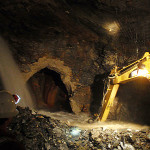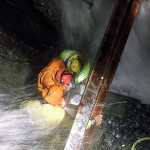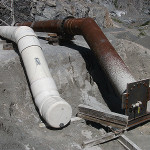Case description
An unexpected water inflow of 1500 USGPM interrupted underwater tunnel construction for a hydroelectric expansion project when an open fracture was encountered that flooded the face of the tunnel and suspended further work until this high-volume inflow could be stopped.
The general contractor requested that Peter White come to the project site and provide hands-on direction of tunnel recovery activities.
Solution
Site inspection revealed that the 1500 USGPM water inflow was associated with a single open rock fracture that was connected to an unlimited water supply from an adjacent lake.
The first stage of recovery was to install several grouting pipes into the flowing aperture, following which a site-fabricated, steel water control gate was installed to cover the aperture location. A temporary wooden sluice was installed through the gate structure to divert as much water as possible through the open gate while subsequent preparations were made.
The perimeter of the steel gate structure was then sealed back to the adjacent rock surface using quick-setting hydraulic cement and water-activated chemical grout that enclosed additional large diameter drainage pipes. After the perimeter seal was in place, formwork was constructed and the steel gate structure was enclosed in concrete.
Prior to the start of cement grouting operations, valves attached to the large diameter drainage pipes were closed, the temporary wooden sluice was removed from the gate and the steel gate was closed and secured. After closing the gate, all of the water flow was stopped, so the only remaining requirement was to fill the water-filled fracture behind the gate.
A high density cement grout was prepared using conventional grouting equipment, with 2% calcium chloride accelerator, and pumped through the available grouting pipes. After placing several cubic meters of high density cement grout behind the steel gate, grouting operations were suspended and the cement grout was allowed to cure.
The following day, probe holes were drilled and confirmed that all open fractures had been sealed by the cement grouting operation.
Photo Gallery
Publication Article
“Tunnel Water Inflow Recovery” – by Peter White, P.Eng.








